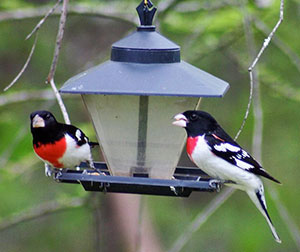Rose-breasted Grosbeak
(Pheucticus ludovicianus)
Description and Range:
Rose-breasted grosbeaks are striking members of the cardinal family (Cardinalidae). These stocky, starling-sized birds sport large bills designed for crushing seeds, fruits, and insects. Males are black and white with a distinctive red chevron extending from their throat down to their breast. In contrast, females and juveniles are streaked brown with a distinct white eye stripe. Both males and females sport white patches in their wings and tail which can be useful for identification.
Rose-breasted grosbeaks can be found throughout the eastern United States during their breeding months. In the winter, they will migrate to central and South America.
Adult male (left) by Dfaulder and female by Simon Pierre Barrette, Wikimedia Commons
Habitat:
Typically, rose-breasted grosbeaks breed in deciduous and conifer forests. Often, they are highly visible during migration when hungry birds visit backyards to fuel their flights with seeds and fruits. In winter, their preferred habitat is often open woodlands.
Reproduction:
Males and females pair up in the spring after a brief courtship. Both parents assist with assembling flimsy, twig-lined nests in the fork of a shrub or tree. Despite its appearance, the nest is held together by forked twigs. Once eggs are laid, both the male and female will take turns incubating the eggs and raising the young. Eggs are pale green to blue in appearance and contain a mix of reddish brown speckles. Blue Jays and Common Grackles will sometimes predate grosbeak nests.
Diet:
Rose-breasted grosbeaks feed on a variety of seeds, fruits, and insects. In the summer, much of their diet consists of beetles, bees, ants, sawflies, bugs, butterflies, and moths. In addition, they will visit feeders in spring and fall to feed on sunflower seed, safflower seed, and/or raw peanuts.
Sounds:
Both males and females sing a song reminiscent of an American robin’s song "GoBack", but the grosbeak’s song is described as more melodious. Interestingly enough, grosbeaks are some of the few bird species that will sing on the nest and males often serenade females before switching incubation duties.
Behavior:
Rose-breasted grosbeaks are very territorial but will tolerate non-singing migrants passing through their area.
Did You Know?
Male grosbeaks will incubate the nest for several hours during the day before handing over duties to the female which will incubate the rest of the day and into the night. While they exchange places, both will serenade each other.
Acknowledgements
- Adult male (left) by Dfaulder and female by Simon Pierre Barrette, Wikimedia Commons
- Red-breasted grosbeaks commonly visit feeders in the spring and fall by Waldo Jaquith, Wikimedia Commons